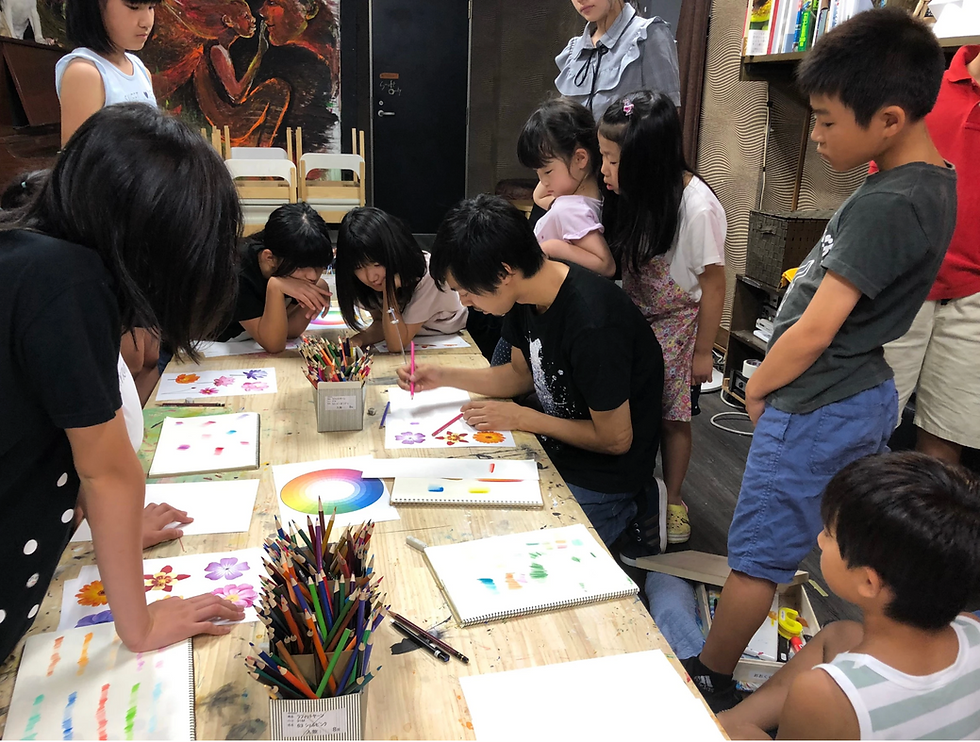[Paco Painting Class]
- ecco inoue
- Nov 8
- 6 min read
Paco Painting School is now in its 10th year.
Three years after painting a mural on a building where Paco is located, Paco got its start.

I never thought I'd start a painting class.
It all started when someone asked me, "Please hold a painting class!" while I was working on a mural. I'm really grateful because if this person hadn't asked me, I would never have even considered it.
Up until then, I had always started things with momentum, but I have a tendency to easily find things I want to do, so although I really wanted to do this, I was very cautious about continuing, having simulated many times the idea of running a "classroom" that would involve many people, including children. And it took me three years.
I am a person who is difficult to explain; I am a florist who also paints, runs a cafe and a live bar, and when I met Harada Akio, a musician and painter, we decided to start a painting class.

Looking back, it seems like the timing was perfect, with Professor Harada and I both having the same amount of free time. If the timing had been a little off, we might not have started.
Being able to "talk" with each other melted away any hesitation I had. The fact that we both had been teaching at vocational schools for many years, that we were involved in "creating something from nothing" in our daily work, and the fact that we simply got along well were also big factors. Friends who get along well as adults are a treasure.

What kind of classroom will you create?
A painting class where you can freely create your own direction and colors based on the instructor's ideas.
There were also opinions that it is taboo to teach drawing to children, as they believe that the skill of drawing may take away the freedom that children have in their soft and free sensibilities.
When we talked about why we both fell in love with drawing, we found that we had a lot in common.
There was a time when I thought I was able to draw it well.
I've been told that I'm good at drawing.
When I drew a shadow, I was like, "Wow!"
So when I think about what it means to be good at drawing, I arrive at the answer: "I often think about it when I can draw what I want to draw in three dimensions just as I imagined it."
This feeling that both of us had when we were in elementary school has become one of Paco's guiding principles. By putting it into words, the fog cleared and his purpose became clearer.
Introducing the concepts and techniques of drawing to elementary school students does not necessarily mean that it will hinder the development of a more flexible sensibility. Rather, I think it will be beneficial for children to be able to draw what they want to draw.
Paco's instruction is relatively specific, and we can see that once you improve, there is an ever-increasing amount of fun waiting for you.

The fact that we were both parents was also a big factor in determining our direction.
Preserving the artwork that children have created.
When you're raising children, you want to preserve their creations, but you end up with an abundance of things that you're unsure of what to do with. Including artwork that your child has forgotten they made, parents decide to dispose of them or keep only photographs. You keep the photographs just in case, but then never see them again.
We also placed emphasis on preserving the works as artworks, taking into consideration the level of completion and materials, as these are works that cannot be created again at that age.
When a mother who has been coming to the school for a long time told me, "My home is starting to look like a museum of my child's artwork," I knew I had achieved my goal! (laughs)

We started with children's and adult classes, held two days a week on Mondays and Thursdays, three times a month.
I put a lot of thought into the assignments I choose each week. "Interesting" is one of the main keywords, but other factors include "what I'll experience," "what I'll put into my body," "how difficult it will be," and "what sense of accomplishment I'll get."

We made a lot of prototypes at night after classes were over. When I came up with a project that I thought was perfect, I got excited imagining what the children would make and draw.
Whether we were fumbling around thinking up assignments or talking about the classroom, we were all looking straight ahead and it was so much fun that I almost lost track of time.
As we worked steadily and diligently, discussing and deciding on each challenge, Paco's collar became thicker and stronger.
Monitors will be introduced from October 2021.
In the summer of 2023, Professor Harada retired from Paco to focus on being a painter. Paco remains strong today thanks to the strong roots we built together over the seven years we spent together, starting from nothing.
Now, Professor Harada occasionally pops in to secretly watch over Paco. He's Paco's precious CEO (laughs).
Currently, the number of instructors has increased to seven, and we work as a team. The teachers are about the same age as my children, and they all also work independently on creative projects. They are about half my age, but there is so much to learn that sometimes, or rather often, I forget my age and rely on them completely.
Shion-sensei and Kotoe-sensei joined Paco in 2019, Haruka-sensei in 2022, Mao-sensei in 2023, and Ruka-sensei and Yuei-sensei in 2025.

They share Paco's way of thinking and what he values in a sincere and earnest way, and everyone is diverse and diverse. I think it's such a great team that I want to shout out loud and say, "I'm so glad everyone came to Paco!" I really feel incredibly lucky to have met these people.
I am the one who mainly thinks about the current issues, and when we need more ideas, we consult with everyone and make the final decision. Sometimes an interesting idea pops up, and I get excited every time.
Everyone is very patient with me because I'm so talkative, so I have to be careful not to become a burden to them (laughs).
I really enjoy the time of trial and error that goes into arriving at a solution.
I make mistakes and forget things very often, and I'm not humble or anything like that, but I consider myself to be a clumsy person who is not cute at all. I don't hide this from the children, adult students, parents, or teachers, and I'm completely open about it. I'm really grateful for all the help I've received.
I can't shake the feeling that it's presumptuous of me to be called a "teacher." As someone who has lived before me, what I can do is to share what I've experienced, to keep on inputting new words and methods to communicate, to apologize and correct myself when I make a mistake or fail, and to love the finished work, the people who made it, and the time I spent with them.

The name "Paco" was chosen because we wanted to create extra space in the "box" that each of us has, and we imagined that extra space would become a slimy, squiggly, and deformable box.
What can we put into the extra space in each person's box for those precious few hours, 36 or 24 times a year? I think we'll continue to experiment in the future.
My comrade, Akio Harada, has now become a painter active not only in Japan but around the world. We have a growing number of new students, and an increasing number of students have never heard of Paco, the school that Professor Harada taught us. Without him, there would be no Paco, so in my next column I would like to write about Akio Harada.



















